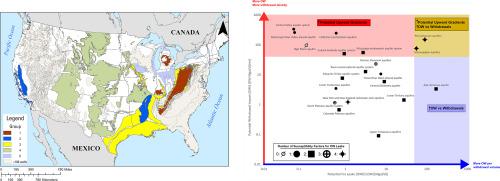美国主要和次级含水层孤儿井水质威胁的地理空间分析
IF 8
1区 环境科学与生态学
Q1 ENVIRONMENTAL SCIENCES
引用次数: 0
摘要
纵观美国石油和天然气生产的历史,为了勘探和能源生产,已经钻了数百万口井。成千上万的未封堵井不再积极生产,目前处于孤儿状态,没有负责任的一方有义务封堵。孤儿井为碳氢化合物和盐水等污染物迁移到供水含水层提供了途径,可能对水资源构成威胁。在这项研究中,我们调查了孤儿井在全国范围内对地下水资源构成的潜在威胁。在全国范围内,关于孤儿井的水质数据很少,可能不适合用于识别石油和天然气开发造成的污染。我们使用地理空间和统计方法来评估哪些主要和次要含水层系统可能最容易受到孤立井的污染。分析涉及三组敏感性因素,包括:1)与孤井数量和密度相关的因素;2)威胁油井完整性和导致污染物运移的因素;3)水质扰动下地下水抽采速率及受影响人群/社区的相关因素。在117,672口孤儿井的数据集中,64,203口位于主要含水层系统内,其余井位于次级含水层系统内。通过评估这些含水层系统中井完整性和水文地质因素的组合,确定了五组主要含水层,其中包括具有大量孤儿井、多个井完整性威胁和高回采的含水层系统,以及具有相对较少的孤儿井、有限的井完整性威胁和最小用水量的含水层。该国有三个地区的含水层更容易受到孤立油气井的污染。这些地区包括1)阿巴拉契亚盆地(包括宾夕法尼亚含水层系统),2)墨西哥湾沿岸含水层(包括沿海低地含水层系统)和3)加利福尼亚含水层(包括加利福尼亚沿海盆地含水层系统)。这项工作是第一次在全国范围内对孤儿井和地下水资源进行多元地理空间调查,并确定了哪些含水层最容易受到孤儿井地下水污染。本文章由计算机程序翻译,如有差异,请以英文原文为准。

A geospatial analysis of water-quality threats from orphan wells in principal and secondary aquifers of the United States
Throughout the history of oil and gas production in the United States, millions of wells have been drilled for exploration and energy production. Hundreds of thousands of unplugged wells are no longer actively producing and are currently under orphan status, with no responsible party obligated for plugging. Orphan wells can pose threats to water resources by providing pathways for contaminants such as hydrocarbons and brines to migrate into water-supply aquifers. In this study, we investigate the potential threats to groundwater resources posed by orphan wells at the national scale. Water-quality data are sparse in relation to orphan wells nationally and may not be suitable for identifying contamination from oil and gas development. We used geospatial and statistical methods to evaluate which principal and secondary aquifer systems may be most susceptible to contamination from orphan wells. Analysis involved three sets of susceptibility factors including: 1) factors related to the number and density of orphan wells; 2) factors that can threaten well integrity and contribute to transport of contaminants; and 3) factors related to groundwater withdrawal rates and the affected populations/communities in the event of water quality disturbances. From a dataset of 117,672 documented orphan wells, 64,203 are located within a principal aquifer system, while the remainder fall within a secondary aquifer system.
By assessing the combination of well integrity and hydrogeologic factors within these aquifer systems, five groupings of principal aquifers were identified, where groups ranged from aquifer systems with high numbers of orphan wells, multiple well integrity threats and high withdrawals, to aquifers with a relatively low number of orphan wells, limited well integrity threats and minimal water use. Three regions of the country emerge containing aquifers with higher susceptibility to contamination from orphan oil and gas wells. These regions include 1) The Appalachian Basin (including the Pennsylvanian Aquifer system), 2) The Gulf Coast Aquifers (including the Coastal Lowlands Aquifer system) and 3) The California Aquifers (including the California Coastal Basin Aquifer system). This work is the first multivariate geospatial investigation of orphan wells and groundwater resources on a national scale and identifies which aquifers are most susceptible to groundwater contamination from orphan wells.
求助全文
通过发布文献求助,成功后即可免费获取论文全文。
去求助
来源期刊

Science of the Total Environment
环境科学-环境科学
CiteScore
17.60
自引率
10.20%
发文量
8726
审稿时长
2.4 months
期刊介绍:
The Science of the Total Environment is an international journal dedicated to scientific research on the environment and its interaction with humanity. It covers a wide range of disciplines and seeks to publish innovative, hypothesis-driven, and impactful research that explores the entire environment, including the atmosphere, lithosphere, hydrosphere, biosphere, and anthroposphere.
The journal's updated Aims & Scope emphasizes the importance of interdisciplinary environmental research with broad impact. Priority is given to studies that advance fundamental understanding and explore the interconnectedness of multiple environmental spheres. Field studies are preferred, while laboratory experiments must demonstrate significant methodological advancements or mechanistic insights with direct relevance to the environment.
 求助内容:
求助内容: 应助结果提醒方式:
应助结果提醒方式:


